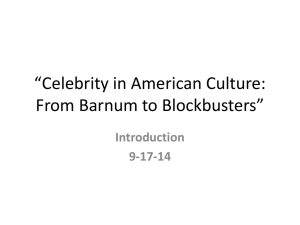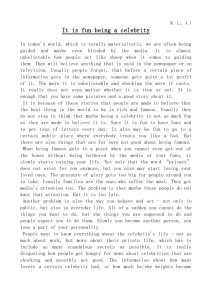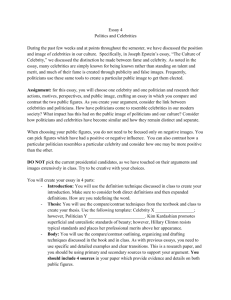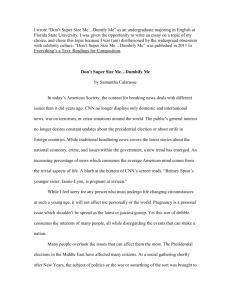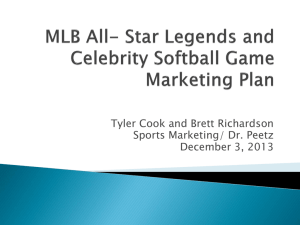Courtney Sparling CMC 200 9/26/12 Annotated Bibliography
advertisement
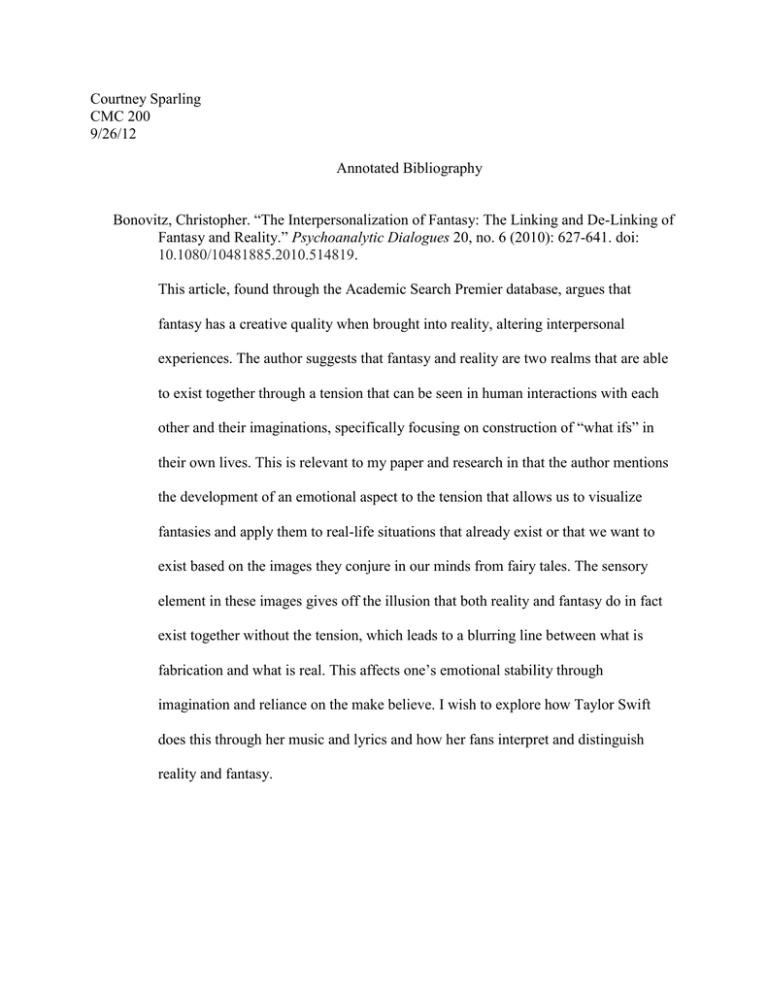
Courtney Sparling CMC 200 9/26/12 Annotated Bibliography Bonovitz, Christopher. “The Interpersonalization of Fantasy: The Linking and De-Linking of Fantasy and Reality.” Psychoanalytic Dialogues 20, no. 6 (2010): 627-641. doi: 10.1080/10481885.2010.514819. This article, found through the Academic Search Premier database, argues that fantasy has a creative quality when brought into reality, altering interpersonal experiences. The author suggests that fantasy and reality are two realms that are able to exist together through a tension that can be seen in human interactions with each other and their imaginations, specifically focusing on construction of “what ifs” in their own lives. This is relevant to my paper and research in that the author mentions the development of an emotional aspect to the tension that allows us to visualize fantasies and apply them to real-life situations that already exist or that we want to exist based on the images they conjure in our minds from fairy tales. The sensory element in these images gives off the illusion that both reality and fantasy do in fact exist together without the tension, which leads to a blurring line between what is fabrication and what is real. This affects one’s emotional stability through imagination and reliance on the make believe. I wish to explore how Taylor Swift does this through her music and lyrics and how her fans interpret and distinguish reality and fantasy. Brown, Adriane. “‘She Isn’t Whoring Herself Out Like a Lot of Other Girls We See’: Identification and ‘Authentic’ American Girlhood on Taylor Swift Fan Forums.” Girlhood in Popular Culture 5, no.1 (2012): 161-180. http://ojs.meccsa.org.uk/index.php/netknow/article/view/252. This article examines two popular fan sites based on Taylor Swift as a performer and the social frameworks presented on the sites of “whiteness and heterosexual romance” (176). The author argues that her fans truly believe that Swift is just an ordinary girl because of the nature of her lyrics that relate so closely to their own personal lives and relationship dilemmas. If Swift sings about the same struggles as every other girl going through a breakup, she must be just a regular girl. Also, the innocence that surrounds Swift characterizes her as an “All-American Girl,” who rejects exposing herself as a sexualized object to the public. This leads to Swift’s identity as a role model for her fans and thus strengthens the interpersonal bond that keeps fans wanting to watch her fame skyrocket while she remains a good, ordinary person. She seems unaffected by the temptations in the spotlight because fans construct an image of her as though she is not even really in the spotlight, but rather as a friend, remaining true to herself and their shared values. Choi, Sejung Marina and Nora J. Rifon. “Who is the Celebrity in Advertising? Understanding the Dimensions of Celebrity Images.” Journal of Popular Culture 40, no. 2 (2007): 304-324. doi: 10.1111/j.1540-5931.2007.00380.x. This article, found through the Academic Search Primer database, explores the ways celebrities are portrayed through the mass media, which creates an “illusion of intimacy,” where one may feel as if he or she personally knows a celebrity. This is why celebrities are used in advertisements so successfully. People see celebrities as credible individuals and therefore have a great influence on consumers and are able to brand their images tied into desired appearances and personas. This article is relevant because it investigates four distinct dimensions of celebrity image from the authors’ research analysis: genuineness, competence, excitement, and sociability. The article focuses on how these play a role in the ways society views celebrities through their images exemplified through the media. A quote in the article that summarizes its relevance to my own paper and celebrities’ ability to have influence and power over society is, “Our worship of celebrities does indeed turn them into the most powerful people on the planet’’ (320). Gabbay, Nicolas, Marie-France Lafontaine, and Claude Lamontagne. “Toward Renewed Constructions and Masculinity and Femininity: Measuring Significant Psychological Differences between Young Men’s and Young Women’s Subjective Experiences in Their Romantic Relationships.” International Journal of Psychological Studies 3, no. 2 (2011): 200-216. doi: 10.5539/ijps.v3n2p200. This article, found through the Academic Search Premier database, describes the differences, somewhat stereotypical and constructed, between young women and men in respect to their intimate relationship experiences with romantic partners. It focuses on the theories of masculinity and femininity, as well as perspectives that define sex roles today. The authors conduct their research through quantitative measures by means of The Questionnaire of Objectivity and Subjectivity and the Bem Sex Role Inventory, which were completed by 134 participants and rates romantic aspects, such as affection and security. Part of the relevant theory in this article states that, “masculinity involves striving to understand, whereas femininity involves striving to be understood” (202). This concept can be applied when I conduct my content analysis of Taylor Swift’s lyrics and music. Ivaldi, Antonia and Susan A. O’Neill. “Adolescents’ Attainability and Aspiration Beliefs for Famous Musician and Role Models.” Music Education Research 12, no. 2 (2010): 179-197. doi: 10.1080/14613801003746568. I found this article through the Academic Search Premier database. It focuses on the influence that famous musicians/singers have on adolescents and the misleading aspirations of becoming just like them. The article characterizes celebrities as significant adolescent role models through results from questionnaires completed by 381 adolescents. The role model can inspire adolescents if they appear to have attainable success. This article further explains how adolescent fans make connections and compare themselves to famous singers when they have similar characteristics and interests. This is relevant to my research in that I wish to explore whether Taylor Swift has similarities and relates to her fans, constructing them to identify with her on a personal level as friends, yet at the same time draw them in closer as loyal fans to herself as a brand. McNamara, Kim. “Publicising Private Lives: Celebrities, Image Control and the Reconfiguration of Public Space.” Social & Cultural Geography 10, no. 1 (2009): 923. doi: 10.1080/14649360802553178. This article that was found through the Academic Search Premier database discusses why celebrities’ private lives are not so private or even real lives at all. The author explains how a sort of “star phenomenon” occurs in the present day. A celebrity is not only seen as a performer on stage, but also as a construction of a specific “character” to the public as himself/herself. There is a blurring line between celebrities’ images as performers onstage and their personal images offstage. The article is relevant in that it states that if a celebrity is characterized as a role model and has a certain commercial image, he or she will carry out a specific character offstage as to maintain that image and character. In my paper, I wish to demonstrate how Taylor Swift upholds her personal life to the public just as she presents her innocent and feminine persona as a performer and role model onstage. Mehrabian, Albert and Jeffrey S. Blum. “Physical Appearance, Attractiveness, and the Mediating Role of Emotions.” Current Psychology 16, no. 1 (1997): 20-42. http://web.ebscohost.com/ehost/pdfviewer/pdfviewer?sid=a0c68f10-b5c9-4201ab19-bfefab3759ba%40sessionmgr110&vid=4&hid=110. This article, available through the Academic Search Premier database, dives into discussing the characteristics that make a person “attractive” to others. The authors’ research method involved showing 76 different photographs of physical attributes to 117 University of California undergraduates, which were rated based on levels of attractiveness. The article focuses on both stable and unstable factors: masculinity, femininity, self-care, pleasantness, and ethnicity. The last four factors relate to Taylor Swift’s image and appearance as a celebrity, which is heavily critiqued and widely recognizable in the media. I wish to use these factors in discussing her attractiveness live in concert, on the red carpet, in her music videos, and during special television appearances in my own paper. I want to conduct in-depth interviews with young women, focusing on each person’s initial emotional reactions to Taylor Swift’s appearance and whether the reactions make form connections to Taylor Swift as a person and, further, her music being likeable or dislikeable. Meyers, Erin. “’Can You Handle My Truth?’: Authenticity and the Celebrity Star Image.” Journal of Popular Culture 42, no. 5 (2009): 890-907. doi: 10.1111/j.1540-5931.2009.00713.x. This article, found through the Academic Search Premier database, focuses on the aspects of fabricated authenticity and genuineness in celebrities. The article suggests that society more often wants to see the individual behind the performances, but celebrities are simply commodities that hide behind images and personas that are portrayed a certain way to gain public favor. An important quote in this article explains celebrity persona as being, “more than false value, rather it is a site of tension and ambiguity in which an active audience has the space to make meaning of their world by accepting or rejecting the social values embodied by a celebrity image” (891). This idea of an active audience is relevant to my research in regards to Taylor Swift’s fans that listen to her music to serve a purpose in their own lives. I will explore the idea of fan devotion to finding deeper meanings within her lyrics and the attraction to Taylor Swift’s “authenticity” during the in-depth interviews I conduct. The relevance of this article is rooted in the plain fact that it discusses how fans can never fully know or understand a celebrity through celebrity media outlets or even his or her performances, because of celebrity persona. A celebrity is a constructed figure, and even his or her biggest fan could not possibly know the truth. But celebrities depend on these invented interpersonal relationships and intimacy that generate loyal fans who truly believe they are close to and familiar with the celebrity just by what they are fed by the media and cultural industry that morph perceptions and reality with commodity and stardom. Soukup, Charles. “Hitching a Ride on a Star: Celebrity, Fandom, and Identification on the World Wide Web.” Southern Communication Journal 71, no. 4 (2006): 319-337. doi: 10.1080/10417940601000410. This article was found through the Academic Search Premier database. It focuses specifically on the ways in which celebrities have become significant influential factors on the Internet. A deep interpersonal relationship is formed through fan sites, blogs, and social media sites through participation in public discourse that allows visibly attractive and fast connections to be produced, virtually limitlessly. Through ethnographical observations, the article researches three themes of sites that promote celebrities: “ a dialogue with the ‘artist’ and the fan community, ‘controlling’ the representation of the celebrity, and personal identification with the celebrity” (319). The article suggests that since these themes prevail on fan sites that there is an even greater influence on the way fans view celebrities and the meaning behind their presented media texts. The article is also relevant in that it explains how people are naturally drawn entertainment and the ideas of sharing and being a part of a larger-than-life celebrity lifestyle. The desire to identify with celebrities is driven by a psychological aspect that is in part, because of the media and the constant flow of images one faces each day. When a celebrity is attractive and likeable or even shares the same similarities as us as media consumers, he or she is more likely to become more popular and easily identified with by millions of fans. Para-social relationships with these celebrities are therefore only illusions of media and production, in which the “cultural economy” continues to rein the fans in to consume more, as the celebrity image expands and dominates. Stever, Gayle. “Fan Behavior and Lifespan Development Theory: Explaining Para-social and Social Attachment to Celebrities.” Journal of Adult Development 18, no. 1 (2011): 1-7. doi: 10.1007/s10804-010-9100-0. This article, found through the Academic Search Premier database, is relevant in that it speaks about the trends formed from fan attachment to celebrities in relation to human lifespan development, specifically focusing on transition stages from childhood to the adolescent years to adulthood. The theories in the article suggest that these fan attachments are formed the same way real, face-to-face relationships are formed through means of, “proximity and familiarity with the face, voice, and manner of the celebrity” (1). Para-social interaction is defined as a one-sided relationship where a fan knows the celebrity, but the celebrity does not know the fan. This can especially be seen in the development of adolescents as they search for their own identity that becomes heavily influenced by media and celebrities in the spotlight. The article also mentions how the Internet makes these para-social relationships even stronger though the wealth of information available about any specific celebrity, fed to fans looking at their computer screens for hours, thus “experiencing” an interactions with the celebrity on a daily basis. Wood, Julia T. “The Can-Do Discourse and Young Women’s Anticipations of Future.” Women and Language 33, no. 1 (2010): 103-107. http://web.ebscohost.com/ehost/pdfviewer/pdfviewer?vid=7&hid=110&sid=a0c6 8f10-b5c9-4201-ab19-bfefab3759ba%40sessionmgr110. I found this article through the Academic Search Premier database. It is relevant to the research I wish to conduct by means of in-depth interviews with young women. The article explains that young women are likely to imagine a future for themselves through images and expectations of society at the time in which they are developing. This can range from expectations of relationships and family life to success in careers and education. This has brought about assumptions that women can do anything and should not limit themselves if others can do the same thing. This relates to how young women compare and identify themselves with celebrities, in hopes of gaining similar success, fame, and public attractiveness.

